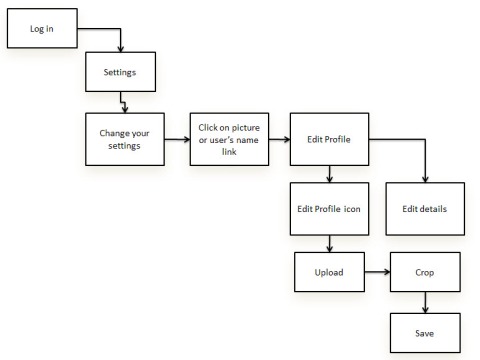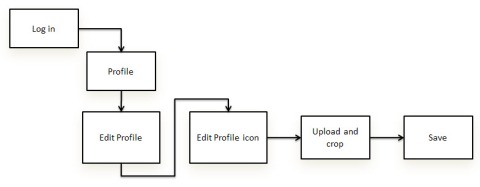COM597c: Final deliverables
December 13, 2009
Summarizing COM597: Theories and Practice of Interactivity
December 6, 2009
Design, usability and interactivity are the concepts we are so familiar with, that sometimes we just underestimate their value and importance. Summarizing our Theories and Practice of Interactivity class, I can say that my biggest take away from it was the understanding of actual importance of a design in our day to day life. If you think a little bit about it, you quickly understand that everything around us is designed by somebody: there are good designs, there are bad ones, but everything man-made has a touch of a designer in it.
Our class assignments helped me complement a theoretical knowledge acquired during the lectures with the practical understanding of basic design principles. The biggest take away from it was the terminology as well as methodology on how to translate business ideas into designers’ language: flowcharts, wireframes, etc. From my past experience, the lack of this knowledge can definitely cause some inconveniences or problems.
Looking at a pruduct from a designer’s perspective, it is easier to figure out what exactly makes a product (un)usable. One of the biggest findings was that very often a part of product’s usability is sacrificed towards its coolness and performance. IPhone is the great example: the in-depth analysis shows multiple usability problems with it. However, the Apple team had managed to find the perfect balance between cool design and actual product’s usability: e.g. on-screen keyboard that is extremely cool, but it covers a significant portion of the screen.
From the other side, online (web) design today matters as never before. the ideas and products are so easy to copy and improve, that sometimes battle of the products transforms into the battle of product designs (which is also accurate for a number of non-virtual products). Bing is the great example. My research helped me to understand, that the way search engine is designed to interact with user matters more than I could previuosly think. More intuitive interface, better usage of a space, great colors and some additional design tricks and solutions that help users solve their existing problems is what’s really important.
Talking about other in-class exercises and home assignments, I should mention that they allowed me to take a look at regular things from a completely new perspective. Thinking about how things are designed and thinking how it is possible to improve their usability was totally refreshing. No matter what is it, a desk with built-in computer or a buzz-in button not to interrupt lectures with questions, it’s just an idea that needs more further development and a designer’s touch to become a reality.
Although I don’t see myself as a designer in a future, an advanced knowledge of theories and practice of interactivity would definitely be helpful for a marketing specialist like me. Talking to designers on their language and understanding how they work may help (honestly, this also helps to shut up sometimes and let them do their work, without derailing them with your own “great” suggestions). Anyways, this was a great class, however it could have been a little bit better if we would spend more time studying more general design concepts without unnesessarily long work-shoppish design exercises during the class time.
How to create service envy on the AT&T developer site?
November 15, 2009
Creating the sustainable service envy is a very complicated process. First and the most important step is creation of a killer product, capable of being a subject for service envy. Extensive research and planning define the success here: finding solutions for problems most mobile application developers face in their day-to-day practice and offering those within a single platform would do it.
Unfortunately, I currently don’t have enough resources to research the topic of mobile application developers’ needs, so I can’t proceed without the following disclaimer: I’m currently operating basing on a limited knowledge of the problem, generously brought to me by a major search engine and on my assumptions.
Tools. Did you know that the first rule of social production is: “Give them tools!”? Releasing SDK won’t be enough. Giving developers more tools that help make their lives easier is the very first step to attracting them. Project management tools, bug tracking systems, interactive feedback soliciting form, some kind of a checker for compatibility across devices etc.
Monetization. Although a lot of developers I meet are really smart and have at least some kind of the business vision of products they work on, none of them would refuse to get some kind of assistance with bringing their applications to the market. Offering them a competitive way to marketplace their products would be good enough to create service envy.
Reputation is one of the most powerful non-monetary riches, truly the currency of Internet. Helping developers to create their personal brand and reach a certain level of reputation and recognition can be as powerful as monetary reward. Unfortunately, a brand of cell phone service carrier isn’t the best to be affiliated with from a standpoint of developer’s recognition (comparing with Apple or Motorola): it’s just to broad and doesn’t provide a direct connection to the technology used. However, there is an advantage in that developers could create applications that could be supported on different platforms and not be locked within certain technology.
Social production opportunity could be an additional advantage which could gain more weight once the number of developers using the platform grows.
Media Space: Profiles
November 8, 2009
My first self-introduction into the Media Space about half a year ago failed miserably: it took me about 10 minutes to figure out how to get to my profile and upload a picture. Things have changed a little bit since that time, however this problem wasn’t fixed.
Let’s see what would it take to upload a new picture to replace the profile icon.

The process of updating (or even accessing) a profile seems to be fairly complicated, making the interface less intuitive. Things are not just where you expect them to be… Subsequently, a small rearrange would fix the problem:
Disclaimer: Although this change seems to be pretty minor, its implementation might require some major changes in how the entire system works. In my opinion, a platform like Media Space should be profile-oriented, not task-oriented like it appears to be now.
Use case
Step 1: User logs in.
Step 2: User clicks on the “(My) Profile”
Step 3: User selects “Edit Profile”
Step 4: User clicks on the “Edit profile icon”
Step 5: User uploads and crops picture
Step 6: User clicks “Save” button
Is Bing a new Big Bang in search market?
November 1, 2009
After its launch earlier this year, Bing has been continuously taking the percentage of the search market share away from its main competitors including Google. It took just few weeks to replace Yahoo as number two. I would be really interesting to know what makes people use it?
First of all, it’s natural curiosity and great marketing efforts behind it. However, in our digital era nothing kills bad product faster than good marketing. Apparently, Microsoft has something else under their belt to make first-time users stick with Bing. My research will reveal, what exactly it is. Better, simpler, and more intuitive interface? New algorithms behind their search? Equipping new Windows 7 and older versions of IE with Bing as a default search engine? My assumptions would be yes, yes, and yes…
However, the question of usability would be the most relevant for this particular case study. I’ve never used Bing before, so my usability tests and further research would have to reveal a couple of really important things:
1. Simplicity. Can you make search even simpler than Google does? Is it what the users want? Maybe they want something else? What is it? How does Bing’s interface address those needs?
2. Intuitive interface. How is it designed? What are possible tasks the end users would want to accomplish? How well is Bing’s design thought through for the completion of these tasks? What could be done to make it better?
3. Innovative solutions. What’s new? What makes Bing different? What’s better and what’s worse?
My goal for the next several weeks is to use Bing for all of my search needs and find out what are the main factors that make it (un)successful.
iPhone: Poor usability vs. coolness?
October 26, 2009
According to multiple online and offline user reviews, iPhone seems to be almost perfect from the usability standpoint. I’ve been using it for a little while, and have to mention that it’s really hard to find some usability imperfections in it.
It’s pretty obvious that Apple engineers had to sacrifice a part of iPhone’s usability to its coolness and performance. The iPhone has a couple of minor to moderate disadvantages, but most of the users are pretty happy with their device.
The first and the biggest usability challenge is definitely a touch-screen keyboard that has tiny buttons and covers a significant portion of a screen. The problem of tiny buttons is not new and almost all the phones I’ve used have it. It’s pretty much impossible to create a large enough keyboard that could be used without any constraints without the increasing a device size.
New concept for an improved classroom/learning experience
October 26, 2009

#MCDMinteractive Week 3 H/A
October 21, 2009
Reputation systems. Practical application
March 6, 2009
I’ve heard some rumors around new Social Mediaspace here at MCDM program. I assume that the creation of some kind of a collaboration platform would be a necessary part of this project. I know that there is a group of people working on it. That’s pretty much all I know about it.
For some reason, not too many people talk about it on Flip the Media blog (which is a little bit surprising). Thus, I’m going to fill this gap…


